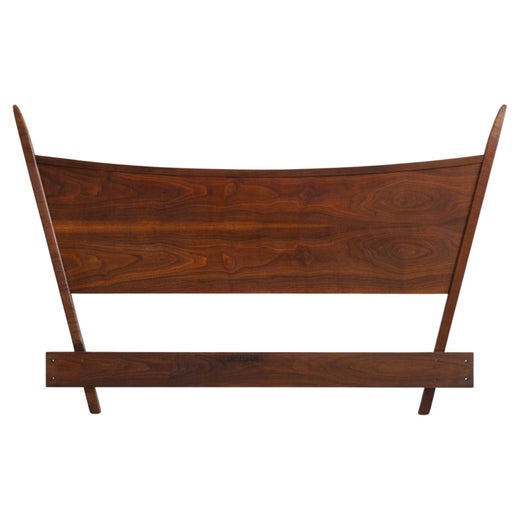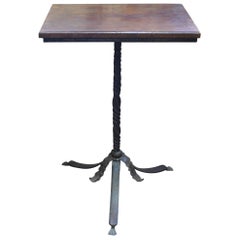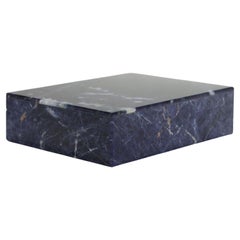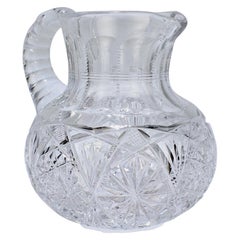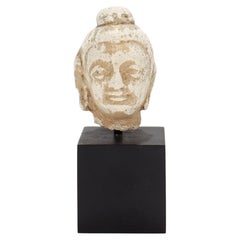Vintage George Nakashima Walnut Plank Stool 'or Small Side Table'
About the Item
- Creator:George Nakashima (Maker)
- Dimensions:Height: 12.75 in (32.39 cm)Width: 16.25 in (41.28 cm)Depth: 16 in (40.64 cm)
- Style:Mid-Century Modern (Of the Period)
- Materials and Techniques:
- Place of Origin:
- Period:
- Date of Manufacture:20th Century
- Condition:Wear consistent with age and use. With a slight wiggle in the legs from dried glue, a flower pot ring at the center of the top, some other spots of staining, minor edge wear and tiny knicks, some fine & light scratches here & there, and other signs of light wear consistent with age.
- Seller Location:Philadelphia, PA
- Reference Number:Seller: DSA-INV1stDibs: LU1610218652262
George Nakashima
A master woodworker and M.I.T.-trained architect, George Nakashima was the leading light of the American Studio furniture movement. Along with Wharton Esherick, Sam Maloof and Wendell Castle, Nakashima was an artisan who disdained industrial methods and materials in favor of a personal, craft-based approach to the design of chairs, coffee tables and other pieces. What sets Nakashima apart is the poetic style of his work, his reverence for wood and the belief that his furniture could evince — as he put it in the title of his 1981 memoir — The Soul of a Tree.
Born in Spokane, Washington, to Japanese immigrants, Nakashima traveled widely after college, working and studying in Paris, Japan and India, and at every stop he absorbed both modernist and traditional design influences.
The turning point in Nakashima’s career development came in the United States in 1942, when he was placed in an internment camp for Asian-Americans in Idaho. There, Nakashima met a master woodcarver who tutored him in Japanese crafting techniques. A former employer won Nakashima’s release and brought him to bucolic New Hope, Pennsylvania, where Nakashima set up a studio and worked for the rest of his life. (Master craftsperson Mira Nakashima keeps her father’s legacy alive at the George Nakashima Studio in New Hope today. She has been the artistic director of George Nakashima Woodworkers since her father's death, in 1990.)
Nakashima’s singular aesthetic is best captured in his custom-made tables and benches — pieces that show off the grain, burls and whorls in a plank of wood. He left the “free edge,” or natural contour, of the slab un-planed, and reinforced fissures in the wood with “butterfly” joints.
Almost all Nakashima seating pieces have smooth, milled edges. Nakashima also contracted with large-scale manufacturers to produce carefully supervised editions of his designs. Knoll has offered his Straight chair — a modern take on the spindle-backed Windsor chair — since 1946; the now-defunct firm Widdicomb-Mueller, the result of a merger between Widdicomb and Mueller Furniture, issued the Shaker-inspired Origins collection in the 1950s.
Nelson Rockefeller in 1973 gave Nakashima his single largest commission: a 200-piece suite for his suburban New York estate. Today, Nakashima furniture is collected by both the staid and the fashionable: his work sits in the collections of the Philadelphia Museum of Art, New York’s Metropolitan Museum of Art and the Smithsonian Institution, as well as in the homes of Steven Spielberg, Brad Pitt, Diane von Furstenberg and the late Steve Jobs.
Find vintage George Nakashima furniture for sale on 1stDibs.
You May Also Like
Mid-20th Century American Mid-Century Modern Side Tables
Walnut
20th Century Spanish Mid-Century Modern Stools
Bamboo, Wicker, Cane, Rattan
20th Century Ivorian Primitive Side Tables
Wood, Reclaimed Wood
Antique Early 1900s Organic Modern Side Tables
Wood, Reclaimed Wood
21st Century and Contemporary Italian Stools
Chrome
21st Century and Contemporary American Minimalist Stools
Walnut
21st Century and Contemporary Vietnamese Minimalist Side Tables
Wood, Oak, Walnut
2010s Canadian Modern Stools
Walnut
Antique Late 19th Century Chinese Chinese Export Side Tables
Wood
Early 20th Century Spanish Rustic Stools
Wood, Pine
More From This Seller
View AllEarly 20th Century American Gothic Revival Candle Stands
Wrought Iron
Mid-20th Century Italian Mid-Century Modern Decorative Boxes
Lapis Lazuli, Silver
Early 20th Century American Barware
Cut Glass
Antique 15th Century and Earlier Indian Sculptures and Carvings
Terracotta, Stucco
20th Century Unknown Mid-Century Modern Bookends
Bronze
Early 20th Century French Art Nouveau Decorative Dishes and Vide-Poche
Pottery
